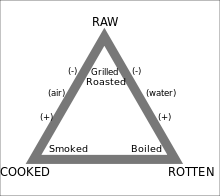Culinary triangle

The culinary triangle is a concept described by anthropologist Claude Lévi-Strauss involving three types of cooking; these are boiling, roasting, and smoking, usually done to meat.
Boiling meat is seen to be a cultural form of cooking because it uses a receptacle to hold water, therefore it is not completely natural. It is also the most preferred way to cook because none of the meat or its juices are lost. In most cultures, this form of cooking is usually conducted by women and is served domestically to small closed groups, such as families.
Roasting meat is a more natural way of cooking because it does not use a receptacle. It is done by directly exposing the meat to the fire. The meat is most commonly offered to guests and is associated with men in many cultures. As opposed to boiling, roasted meat can lose some parts during cooking, thus it is also associated with destruction and loss.
Smoking meat is also a natural way of cooking. It is also done without a receptacle and in the same way as roasting. It is a slower method of roasting, however, which makes it somewhat like boiling.
According to Claude Lévi-Strauss, other cooking methods could be situated within this triangle. For example, grilling meat, by nature of the meat being situated with "with lesser distance [...] to fire", could be situated "at the apex of the recipe triangle" (above the roasted), while steamed food, located further from the water than boiled, would be placed "halfway between the boiled and the smoked."[1]
Notes
- ↑ Lévi-Strauss, "The culinary triangle", p. 43 (= p. 34 in first edition).
References
- Lévi-Strauss, Claude (2008) [1997]. "The Culinary Triangle". In Carole Counihan and Penny Van Esterik. Food and Culture: A Reader. Peter Brooks (trans.) (2nd ed.). New York: Routledge. pp. 36–43 (28–35 in first edition). Originally published as:
- Lévi-Strauss, Claude (Autumn 1966). Peter Brooks (trans.). "The Culinary Triangle". The Partisan Review. 33: 586–96.
External links
- Claude Lévi-Strauss, "The Culinary Triangle", in Food and Culture: A Reader (2nd ed.). Available from Google Books.
- Cooking Vocabularies and the Culinary Triangle of Lévi-Strauss, by Adrienne Lehrer Anthropological Linguistics © 1972 Anthropological Linguistics.
- Article discussing the Culinary Triangle (Claude Levi-Strauss: Oysters, Smoked Salmon, and Stilton Cheese) by Edmund Leach